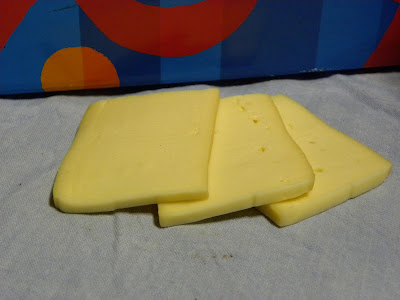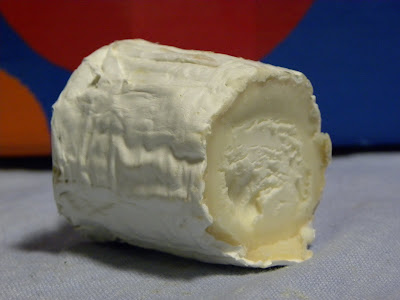So in the interest of those who have been asking us about cheese, I got the cheeses out of our Fridge and took pictures of them. There are actually more types of cheese here than you could try in a year if you tried more than one different cheese a day in that year, never repeating.
First off, let's go with a cheese everybody has at least heard of: Roquefort
 I know what some of you are saying: "Hey! That's Blue Cheese!" and yes, you'd be correct, but in France, there are many varieties of «fromages bleu» and Roquefort happens to be one of them. Here, if your blue cheese is crumbly, that means that it isn't worth putting on the table; in fact, it'd probably be best to just use it to catch mice. Good blue cheese is moist and spreadable, like our cream cheese and the blue cheese here spread on a piece of fresh bread is really quite an experience.
I know what some of you are saying: "Hey! That's Blue Cheese!" and yes, you'd be correct, but in France, there are many varieties of «fromages bleu» and Roquefort happens to be one of them. Here, if your blue cheese is crumbly, that means that it isn't worth putting on the table; in fact, it'd probably be best to just use it to catch mice. Good blue cheese is moist and spreadable, like our cream cheese and the blue cheese here spread on a piece of fresh bread is really quite an experience.Next up: Fouchtra Vieux, or Ol' Fouchtra

When I saw this cheese at market, I thought to myself, "It looks like they rolled that cheese in dirt!" So I bought a piece. Upon looking at it closer, I think they really did, here look at it closer

You can actually see the grains of dirt or whatever it is that they rolled it in. When we asked some French people what it was, they simply responded that it was the «moisissure» or mold that grows on it, but I ain't never seen mold like that! Anyway, it is really delicious and when they have cheese here, you're supposed to eat it from most creamy to most sharp and this lies in the middle somewhere.
Next on the list is Raclette

Raclette is used as a melting cheese and usually poured over potatoes, but it is pretty versatile and creamy. Oddly enough, the cheese is cut into squares, but the little Raclette melting pans they have are triangular so that you have to cut a little bit off of each square to fit it in there.
Next is possibly the king of French Cheeses:

Brie
And this is no ordinary Brie, this is the Brie de Meaux, the real Brie that, yes, is actually illegal to mass market in the U.S. because of how they treat the milk. This Cheese is alive. It smells like broccoli shouldn't but somehow you want to eat it anyway and I even had to cut off a slice after taking this picture. The first house I entered in France I thought I smelled old dirty diapers, but now that I know what I'm smelling, I realize they must have had a pretty expensive arsenal of Cheese.
And now for a change in Animal byproduct: Le Chevre (that's "goat" for you Anglophones out there)

Always seen in this form and with the white rind, Chevre is a very eatable cheese. It isn't as much like feta as you'd expect since that is what American's know of goat's cheese. It's somehow creamy and sharp at the same time and I personally have a hard time knowing when to eat it with other cheeses since it is so easy to eat and yet so powerful at the same time.
The reason that the French even find importance in the order of their cheeses is that if you were to eat say the Brie de Meaux then a Camembert, you wouldn't taste the Camembert at all. By finding the perfect order of cheeses, you find a kind of cheese Zen, if you will.
Lastly, I'll show you what happens when good cheese goes bad

This cheese was left in our fridge and we forgot all about it. It was a pretty incredible goat cheese mixed with herbs de provence. Don't worry, the large ovular object on it is an olive garnish. We're actually pretty sure that the green stuff doesn't go deep and that we can cut it off and enjoy the cheese again!
The next one we're not sure about:

Amber thinks it may have been a bleu at one point, but I don't know, I think it looks too much like banana pudding. And just to let you know, I was able to pull the wrapping off of several other of these cheeses, but this one... WHEW! It reminded me of the smell when I had to clean my Cocker Spaniel's ears, but hey, I might try it out anyway.
*Editorial Note* After talking with another person here more about the Roquefort cheese, I found out that what makes Roquefort cheese real "Roquefort" is that it is made in the region of Roquefort and from sheep's milk. It is as with wine, an AOC cheese, meaning that it has certain regulations about its production and you could find another cheese that tastes exactly like it made in the exact same way, but if not from Roquefort, it is sadly just blue sheep's cheese. Kind of like California's sparkling white wine cannot be called Champagne.


Go cheese!
ReplyDeleteCharles, I really enjoy the way you write. Good humor! Makes me crack a smile every time.
ReplyDeleteI was thinking about cheese. You know, I don't know the last time I ate cheese! Chinese don't do cheese. It makes them sick. I guess I must have eaten some in July in the States.
This is one way in which our lives are profoundly different. We don't do the decayed, moldly, dirt-rolled, dog-ear-smell dairy product here...and you guys have a different type for every day of the year.
Now you've really got me thinking about the stuff. I think I want to eat some. Anyway, great post, keep em comin.
Actually, the first kind of cheese that you said "everyone should know" I didn't know. haha! Shows me! I am jealous. I think me and France would get along great. I love cheese so much ,I too think we should have an entire course of our meal in America dedicated to cheese! I want to try every one of those cheeses (except the moldy ones).
ReplyDeleteI love reading your stories from the French Countryside. I miss you guys :-) Charles I saw a unicorn picture the other day and thought of you.
ReplyDelete